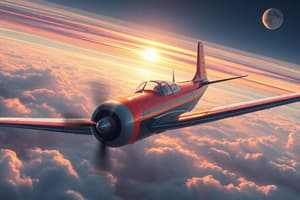Podcast
Questions and Answers
What is the primary purpose of flight schools?
What is the primary purpose of flight schools?
- Train individuals to become pilots (correct)
- Offer ground transportation services
- Provide recreational flying opportunities
- Conduct research on aviation safety
Which type of flight school offers more flexibility in training?
Which type of flight school offers more flexibility in training?
- Part 61 Schools (correct)
- Part 141 Schools
- Integrated Training Programs
- Commercial Schools
What is a requirement for obtaining a Private Pilot License (PPL)?
What is a requirement for obtaining a Private Pilot License (PPL)?
- At least 200 flight hours
- At least 100 flight hours
- At least 40 flight hours (correct)
- At least 50 flight hours
What type of training combines ground and flight instruction for aspiring professional pilots?
What type of training combines ground and flight instruction for aspiring professional pilots?
What is the highest level of pilot certification required for airline captains?
What is the highest level of pilot certification required for airline captains?
Which of the following is a key component of flight training?
Which of the following is a key component of flight training?
What should one consider when choosing a flight school?
What should one consider when choosing a flight school?
Which financing option is commonly available for flight training?
Which financing option is commonly available for flight training?
Flashcards are hidden until you start studying
Study Notes
Overview of Flight Schools
- Definition: Flight schools are educational institutions that provide training for individuals aspiring to become pilots.
- Types of Flight Schools:
- Part 61 Schools: More flexible programs; tailored to individual student needs.
- Part 141 Schools: Structured programs with a set curriculum, approved by the FAA.
Key Components of Flight Training
- Ground School: Theoretical instruction covering:
- Aviation regulations
- Navigation
- Weather
- Aircraft systems
- Flight Training: Practical flying experience; includes:
- Flight maneuvers
- Emergency procedures
- Cross-country flying
Licenses and Certifications
- Private Pilot License (PPL): Basic license allowing personal flying.
- Instrument Rating (IR): Permits flying under instrument flight rules.
- Commercial Pilot License (CPL): Allows pilots to be compensated for flight services.
- Airline Transport Pilot License (ATPL): Highest level of pilot certification, required for airline captains.
Curriculum and Training Hours
- Minimum Flight Hours: Varies by license:
- PPL: At least 40 hours
- CPL: At least 250 hours (depends on training type)
- ATPL: 1500 hours total
- Flight Hours Requirement: Supervised by certified flight instructors.
Costs and Financing
- Tuition Costs: Can range significantly based on school type, location, and aircraft used.
- Financing Options: Scholarships, loans, and payment plans available.
Training Paths
- Accelerated Programs: Intense, fast-paced training for quicker attainability of licenses.
- Integrated Training Programs: Combine ground and flight training, often for professional pilots.
Considerations When Choosing a Flight School
- Accreditation: Verify if the school is recognized by aviation authorities.
- Aircraft Fleet: Check the condition and variety of aircraft available.
- Instructor Qualifications: Look for experienced and qualified flight instructors.
- Location: Consider air traffic and weather conditions for training.
Career Opportunities Post-Training
- Commercial Pilot: Fly for airlines, cargo, or charter services.
- Flight Instructor: Teach aspiring pilots.
- Specialized Roles: Agricultural, aerial photography, or surveying pilots.
Safety and Regulations
- FAA Regulations: Adherence to Federal Aviation Administration guidelines is mandatory.
- Safety Protocols: Strict procedures for maintenance and operation to ensure safety in training flights.
Conclusion
- Flight schools are essential for anyone looking to pursue a career or hobby in aviation, providing a structured framework to learn flying skills and aviation knowledge.
Flight School Overview
- Flight schools offer training for aspiring pilots.
- Two main types: Part 61 (flexible) and Part 141 (structured, FAA-approved) schools.
Flight Training Components
- Ground school: Theoretical instruction on regulations, navigation, weather, aircraft systems.
- Flight training: Practical flying experience including maneuvers, emergencies, cross-country flying.
Licenses and Certifications
- Private Pilot License (PPL): Allows personal flying.
- Instrument Rating (IR): Allows flying under instrument flight rules.
- Commercial Pilot License (CPL): Allows pilots to be paid for flight services.
- Airline Transport Pilot License (ATPL): Highest level, required for airline captains.
Curriculum and Training Hours
- Minimum Flight Hours Required: Varies by license:
- PPL: At least 40 hours
- CPL: At least 250 hours (depending on training type)
- ATPL: 1500 total hours
- Flight hours: Supervised by certified flight instructors.
Costs and Financing
- Tuition: Ranges greatly based on school type, location, and aircraft.
- Financing: Scholarships, loans, and payment plans are available.
Training Paths
- Accelerated Programs: Intense, fast-paced training for quicker licensing.
- Integrated Training Programs: Combine ground and flight training, often for professional pilots.
Choosing a Flight School
- Accreditation: Verify recognition by aviation authorities.
- Aircraft Fleet: Check aircraft condition and variety.
- Instructor Qualifications: Look for experienced and qualified instructors.
- Location: Consider air traffic and weather for training.
Career Opportunities
- Commercial Pilot: Airlines, cargo, or charter services.
- Flight Instructor: Teaching aspiring pilots.
- Specialized Roles: Agricultural, aerial photography, surveying pilots.
Safety and Regulations
- FAA Regulations: Mandatory adherence to Federal Aviation Administration guidelines.
- Safety Protocols: Strict maintenance and operation procedures for safe training flights.
Studying That Suits You
Use AI to generate personalized quizzes and flashcards to suit your learning preferences.




